Uncategorized
A 24-Hour Workday
A 24-Hour Workday at Duke
Around the clock and world, staff and faculty drive Duke’s strategic vision
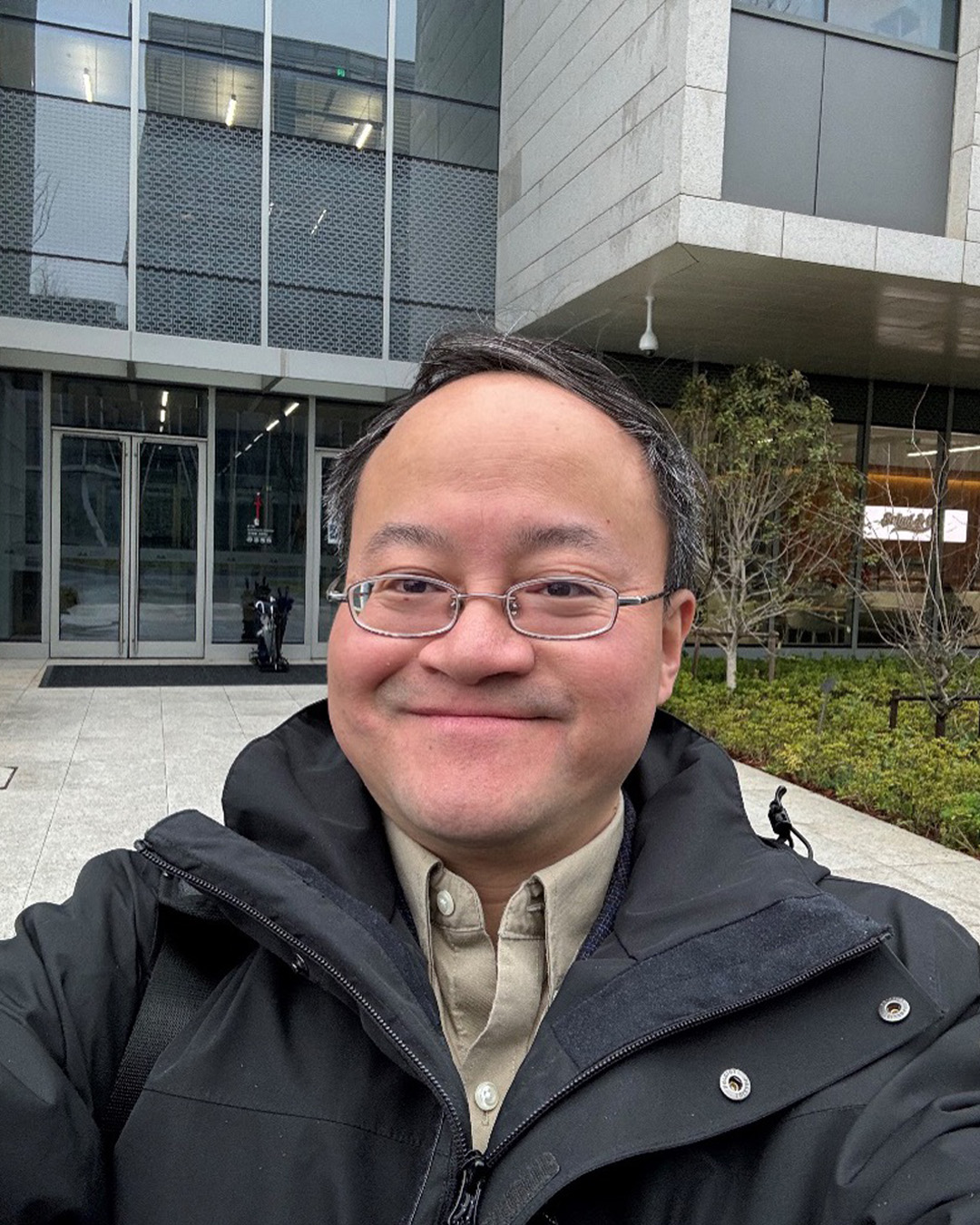
Duke Kunshan University Professor of Electrical and Computer Engineering Xin Li poses for a selfie in front of his office in the Innovation Building on Duke’s campus in Kunshan, China. Photo courtesy of Xin Li.
After a day that included teaching a machine learning course and speaking with master's students about group projects and mid-terms, Electrical and Computer Engineering Professor Xin Li is ready for dinner.
Li, who has taught at Duke Kunshan University (DKU) in Kunshan, China, since 2017, leaves his second-floor office in the glass-walled Innovation Building a little after 5 p.m. The rain that fell most of the day has stopped, giving Li a pleasant walk to the dining hall. As he strolls, he ponders how Duke's campus in China has grown.
Established in 2013 in partnership with Wuhan University, DKU has 605 faculty and staff, and 1,713 students drawn from 67 countries by innovative scholarship and cross-cultural collaboration.
“When I got here, we only had five buildings, now we have more than 20,” says Li, who oversees DKU's graduate programs and research activities and visits Durham once a semester.
As Li sits down for dinner this evening in February, about 7,600 miles away on the other side of the world, it's around 4 a.m. For most colleagues in Durham, the workday has yet to begin.
While Duke's 45,502 staff and faculty support priorities related to education, research and patient care, their workdays are wildly different. Employees at Duke – North Carolina's second-largest private employer – do a vast array of jobs across the state, nation and world.
“Most people don't realize that higher education is one of, if not the, most complex employer types in the United States,” said Andy Brantley, President and Chief Executive Officer of the College and University Professional Association for Human Resources (CUPA-HR). “Institutions like Duke are highly complex and with a breadth and depth of missions that necessitate 24/7 operations and employees in multiple states and countries.”
Over a day in February, discover how colleagues share their talents around the clock, playing pivotal roles in Duke's larger story from different locations.
5:30 a.m.
A Delicious Morning Ritual
The sky is dark when Barbara Phelmetta hurries into a back door of the George and George-Frank Wall Center for Student Life on East Campus, her 4-foot-9 frame bundled in a hoodie to ward off the chill.
She's been awake for nearly two hours, and it's time to start making breakfast for 600 to 800 people.
Phelmetta, 58, has been cooking for as long as she can remember and started fixing meals for Duke's campus when she was 20 years old. Now she works the early shift as part of the 70-member Duke Dining team on East Campus.
Serving food is her love language. She's just as happy to do it for the alums who come back to campus for her catfish or honeybun cake as she is for the 26 family members who ate Christmas dinner at her home.
“I like my job. I like what I do,” the Lead Production Worker says. “I love to cook, and I like the people.”
There's a rhythm to everything she does while striding through the campus kitchen. Mix the butter into the grits at 6:28 a.m. Thicken the fruit compote at 6:37 a.m. Season the sausage gravy with a bit more pepper at 6:42 a.m. And at 6:51 a.m., line baking pans with bacon.
By 7:15 a.m., it's all ready to be devoured.
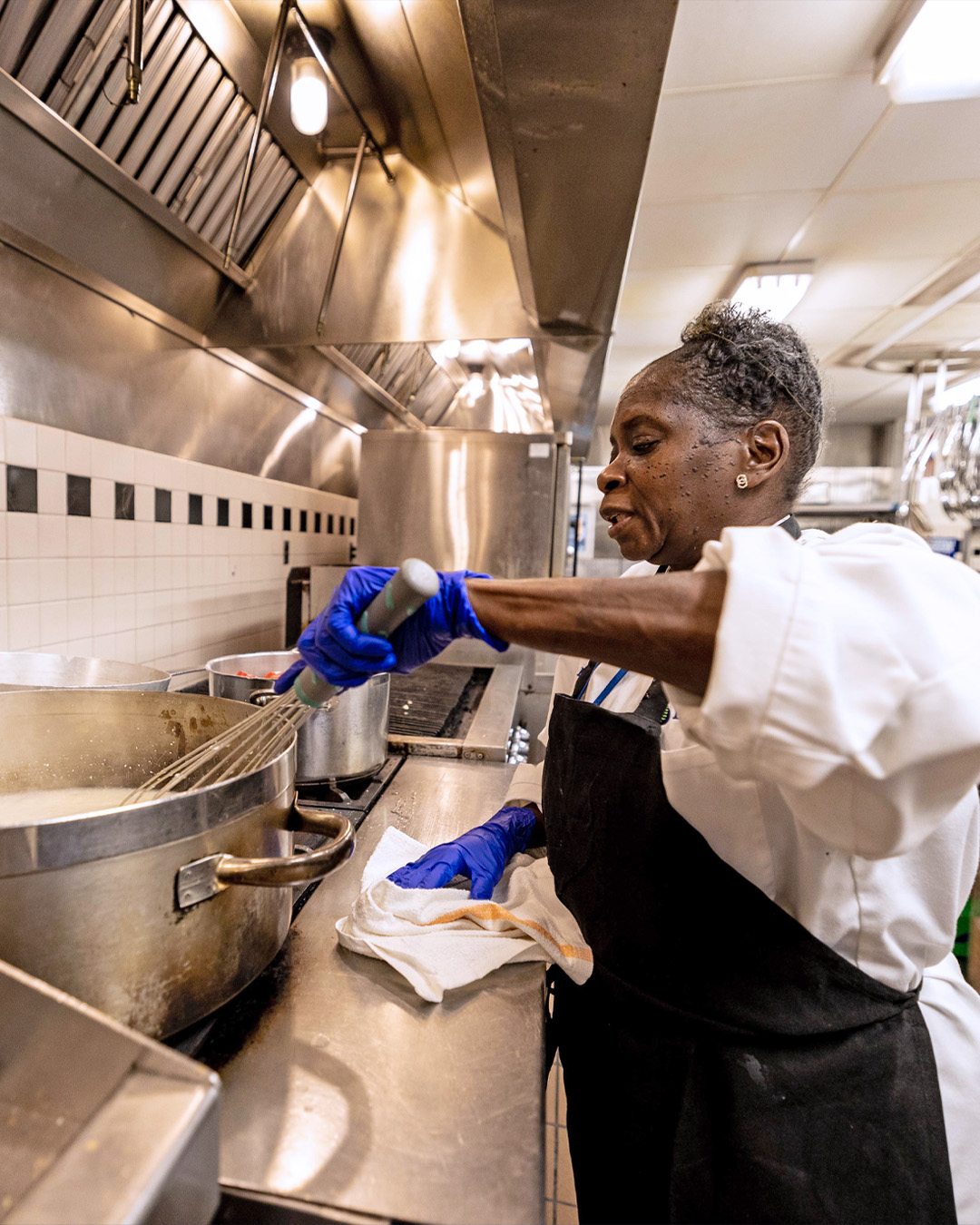
Barbara Phelmetta stirs a pot of grits as she helps prepare breakfast in the George and George-Frank Wall Center for Student Life on East Campus.Photo by Travis Stanley.
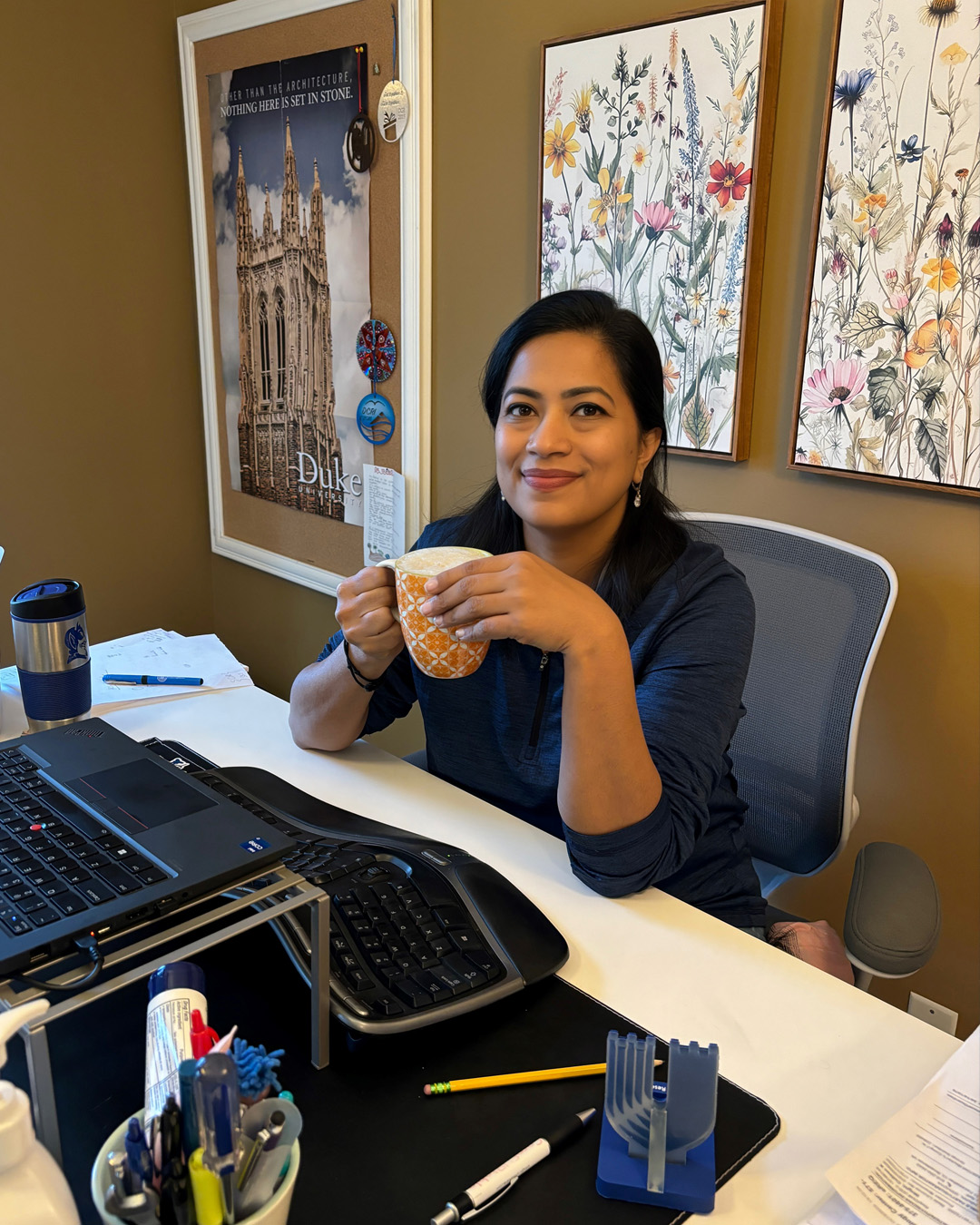
Vidya Raghavan of the Duke Clinical Research Institute begins her workday from her home office in Ashburn, Virginia. Photo courtesy of Vidya Raghavan.
7 a.m.
A Home Office in Virginia
Lit with morning sun, Vidya Raghavan sits in her home office with a mug filled with Trader Joe's Five Country Espresso Blend.
At Duke since 2011, Raghavan, Associate Director for Vendor Management for Duke Clinical Research Institute (DCRI), has worked from Ashburn, Virginia, since 2015, when she relocated from Chapel Hill for her husband's job.
Raghavan leads a four-person remote team negotiating vendor proposals for tasks such as drug distribution and lab analysis for DCRI trials. The work requires close communication with remote colleagues, Durham-based collaborators, and vendor contacts from around the globe. Last year, her team facilitated 526 vendor proposals and resubmissions.
“I get to do very exciting work,” Raghavan says. “The Duke brand is huge in our industry. I get to meet a lot of different people, and they always want to work with us.”
Raghavan is among the 547 Duke employees working in 20 approved states/districts outside of North Carolina. A recent CUPA-HR survey reported 89% of colleges and universities have out-of-state employees.
This morning, Raghavan examines notes for a 10 a.m. meeting about an upcoming study, wades through 92 emails and maps out her day. She compares her day to the video game Tetris.
“I try to figure out how to fit pieces in to make patterns and anticipate my workload,” Raghavan says. “This uninterrupted time is when I do that.”
11 a.m.
The Smallest Details Illuminated
The instrument before Lisa Cameron is as large as an oven with wires and tubes protruding from all angles that make it look like a Frankensteined creation. The Leica 2photon DIVE microscope is, in fact, worth about $1 million.
And Cameron loves helping researchers learn the best way to use it.
“My favorite thing is to work on a microscope with people,” she says.
Cameron, Associate Research Professor in the Department of Biology, directs the Light Microscopy Core Facility, which operates 24 hours a day, seven days a week. Researchers from 150 campus labs – primarily in Biology, Chemistry, Physics, Neuroscience, the Pratt School of Engineering and School of Medicine – visit the facility to access some of the country's most advanced imaging instruments.
The Duke University School of Medicine is one of the largest biomedical research enterprises in the country with programs focused on the causes, prevention and treatment of human disease. In 2022-23 Duke University surpassed $1.39 billion in total research expenditures with more than $901 million in federally sponsored research spending.
The Leica, and the facility's other high-tech confocal and widefield fluorescence microscopes, allow researchers to view things that many typical microscopes can't reveal.
“We provide microscopy expertise to help researchers perform and improve their microscopy image collection and analysis,” Cameron says. “And we help them answer their experimental question. It's more than just the equipment.”
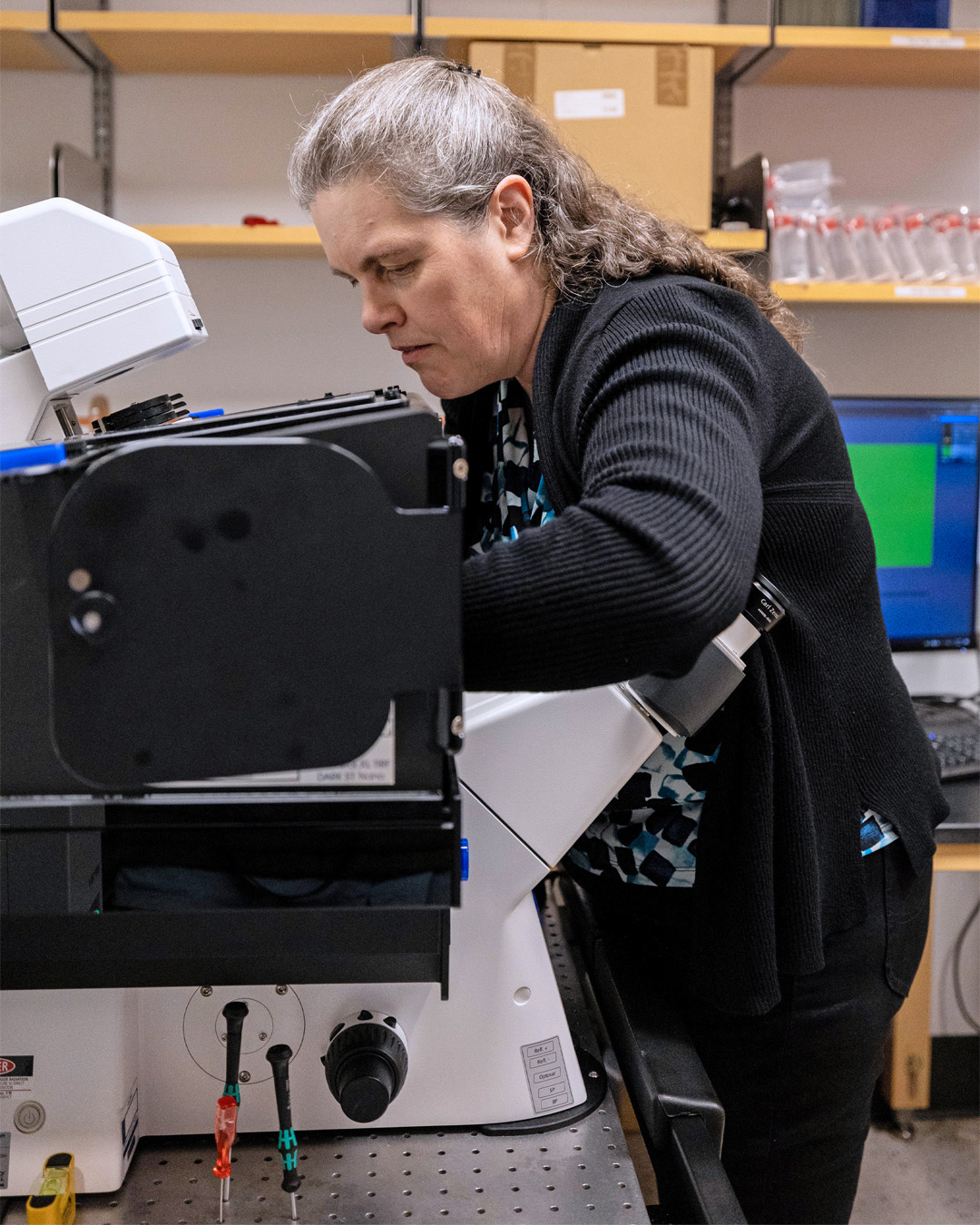
Lisa Cameron, Associate Research Professor in the Department of Biology, works with an instrument in the Light Microscopy Core Facility. Photo by Travis Stanley.

Duke in DC Program Coordinator Kishanna Harley speaks with students from the Sanford School of Public Policy. Photo courtesy of Kishanna Harley.
11:30 a.m.
‘Ambassador for the city’
Kishanna Harley is sitting alongside 10 students in Duke's Washington, D.C., offices, listening to questions asked of a guest speaker from the Smithsonian Anacostia Community Museum.
The students, who are part of the Sanford School of Public Policy's semester-long Duke in DC program, want to know how the city's transportation, education and housing policies have shaped different neighborhoods.
A Washington, D.C., resident for most of her adult life, Harley, 44, enjoys hearing students dig into her city's complicated history.
“This is about making the connection that the work they want to do, whether it's public policy or political science, will shape people's lives,” says Harley, Program Coordinator for Duke in DC.
Harley is a former teacher, librarian and museum consultant who joined Duke's staff in 2023 to coordinate the Duke in DC program. She helps students connect to the city by doing everything from inviting guest speakers to ensuring students' Metrorail cards are funded.
“It's like all of my past work lives are converging into one role,” Harley says. “I'm an ambassador for the city I call home. I get to serve my community by helping these students understand D.C. better.”
12 p.m.
Delivering Care in a Town of 3,064
Christianna Karr, a Nurse Practitioner at Duke Primary Care Louisburg, steps into one of the clinic's eight exam rooms to type notes from the morning's final visit.
Karr started as a Duke nurse in 2012 on Duke University Hospital's seventh floor. Since 2019, she's seen patients at Duke's Louisburg clinic, which is tucked in a one-story brick building about 43 miles northeast of Durham. It's one of the most remote clinics in the Duke Primary Care system.
“Out here, we have sweet, genuine people who are really thankful for care,” says Karr, who, a day earlier, received a Valentine's Day cake from a patient.
In the 2022-23 fiscal year, Duke University Health System had nearly 5 million outpatient encounters at 426 clinics and care locations serving North Carolina communities.
By noon on this day in February, Karr had seen five patients in-person and four by virtual appointment, helping people with cold symptoms, diabetes and high blood pressure. Unlike other clinic staff members, Karr isn't from Louisburg. But after nearly five years in the town of 3,064, Karr cherishes the community bond.
“In a small town,” she says, “everyone is connected.”

Duke Primary Care Nurse Practitioner Christianna Karr types notes from visits with patients at Duke’s Louisburg clinic. Photo by Travis Stanley.
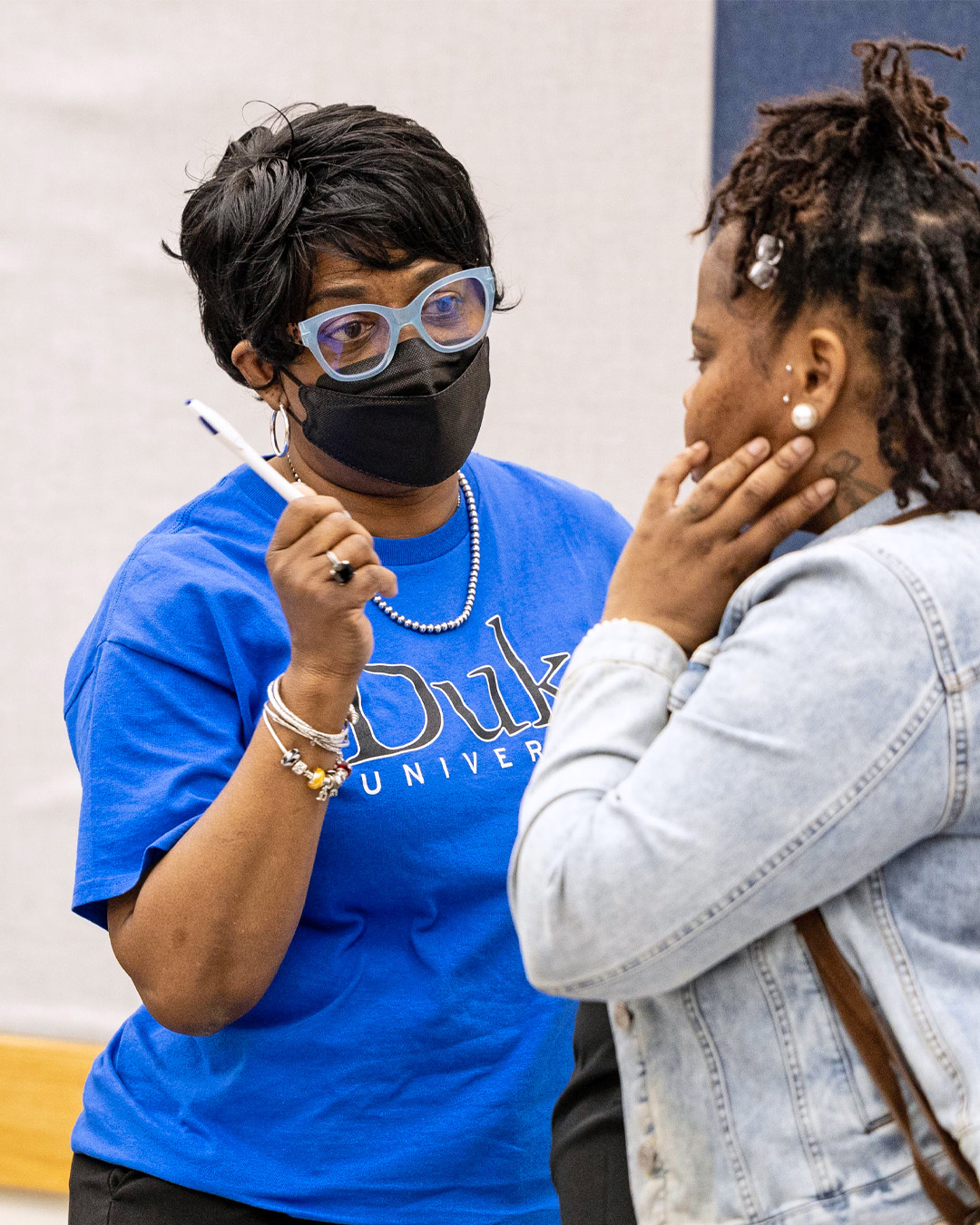
Loretta Barrett, left, a Recruiter with Duke Human Resources, speaks with a job hopeful at a career fair for the Duke Facilities Management Department. Photo by Travis Stanley.
1:30 p.m.
Recruiting New Talent
A steady flow of job seekers pass through a Smith Warehouse conference room for a career fair hosted by the Facilities Management Department.
Loretta Barrett, a Recruiter with Duke Human Resources, sits at a table with a pair of laptops, helping job hopefuls for landscape services, housekeeping and other roles set up profiles in Duke's online hiring system.
Around 1:30 p.m., she eats the turkey sandwich and butternut squash soup that's sat on her table since around noon.
“I think we've found some good people,” Barrett says.
In 27 years as a recruiter at Duke, Barrett has seen job postings go from papers tacked to bulletin boards to a fully online system. Most days, she monitors the flow of applicants for areas such as Athletics and reads applications, determining who moves to hiring managers.
Last year, Duke fielded applications from 89,744 people for 4,002 positions.
“There's stability here,” Barrett says. “You have people that care about you, that will work with you and help you move forward. Duke is a large place, so you'll have an opportunity to enhance your skills, change your career path and move toward your dream job.”
3 p.m.
Seeking Truth and Donuts
Andrew Janiak bursts into room 118 at the Friedl Building on East Campus carrying a duffel bag that holds the key to eight students' happiness.
He's brandishing a box of Monuts donuts because his Historical and Philosophical Perspectives on Science class argued that a lesson on science and philosophy in the early 18th century examining Leibniz and his use of the word “monads” was too similar to the delicious Ninth Street bakery's name to go unrecognized.
Janiak forgot napkins.
“You're just going to have to get donut grease on your Kuhn notes,” he says, chuckling.
Today the class is comparing high-level theories of Newton and Einstein as dissected by Thomas Kuhn when one student says, “I hate to make this move, but what do you mean by ‘truth?'”
At the head of the graduate seminar table, Janiak smiles. The Professor of Philosophy has been doing this for 21 years at Duke, as one of 4,109 faculty members teaching 16,539 undergraduate and graduate students. And it never gets old.
“Why do I do it? There are three reasons, basically: the students, the students and the students,” he says.

Professor of Philosophy Andrew Janiak explains a concept to graduate students in a Historical and Philosophical Perspectives on Science seminar. Photo by Travis Stanley.

Lamar Walker, Associate Director in Student Involvement and Leadership, engages students with personal stories during an Event Planning and Risk Management training class. Photo by Travis Stanley.
6 p.m.
Seeing Every Student’s Potential
Lamar Walker knows part of being an effective event planner is quick thinking. So, when he discovers the Bryan Center space reserved for his Event Planning and Risk Management leadership training class is double-booked, he pivots.
“This is literally event planning on the fly,” Walker, the Associate Director in Student Involvement and Leadership, tells 17 students as he leads them down the hall to an empty room.
The room is stuffy and cramped, but it works. And when Walker launches into his presentation on risk management, he makes a formal topic engaging, sharing personal stories while he talks with his whole body – gesturing with his hands and scrunching his face for emphasis. He peppers his presentation with, “Does that make sense?” and explains, “I ask that question a lot. I don't say it to be cute. I actually want to know.”
Duke has 605 registered student organizations, and Walker works to ensure groups are formally recognized and students running them feel supported.
“I have always been a person that sees potential,” Walker says. “And I think that the ability to work with student organizations really allows me to help others fulfill the potential that they see and the potential that I see in them.”
Barbara Phelmetta, Andrew Janiak and Christianna Karr share how their roles at Duke have connected them to purpose and the community.
Story by Senior Writers Stephen Schramm and Jodie Valade; Video by Travis Stanley, Multimedia Producer. Editorial direction by Leanora Minai.
Send story ideas, shout-outs and photographs to Working@Duke by writing working@duke.edu.
Follow Working@Duke on X (Twitter), Facebook, and Instagram.
